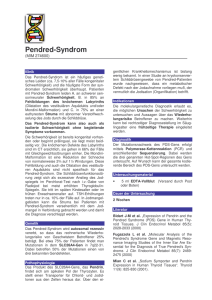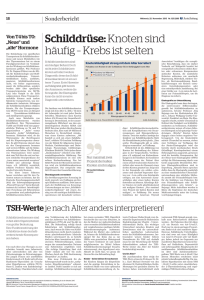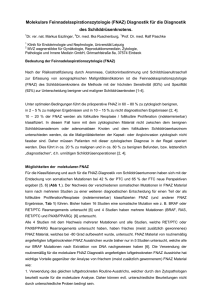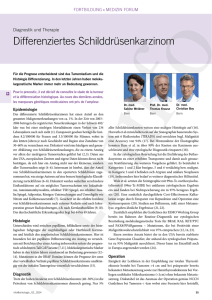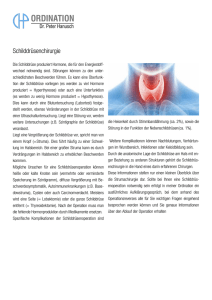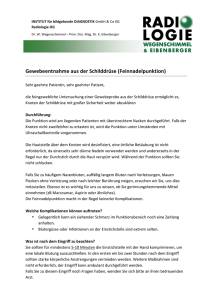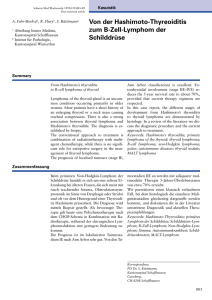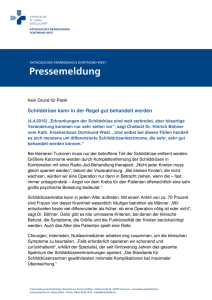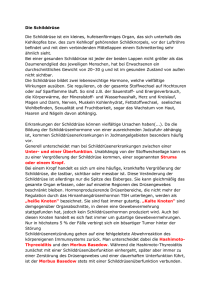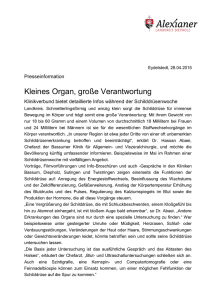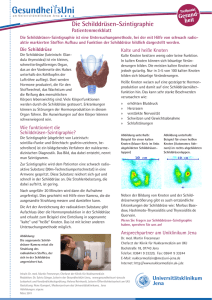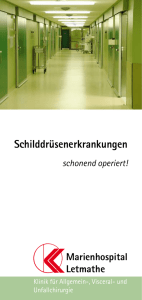Document
Werbung
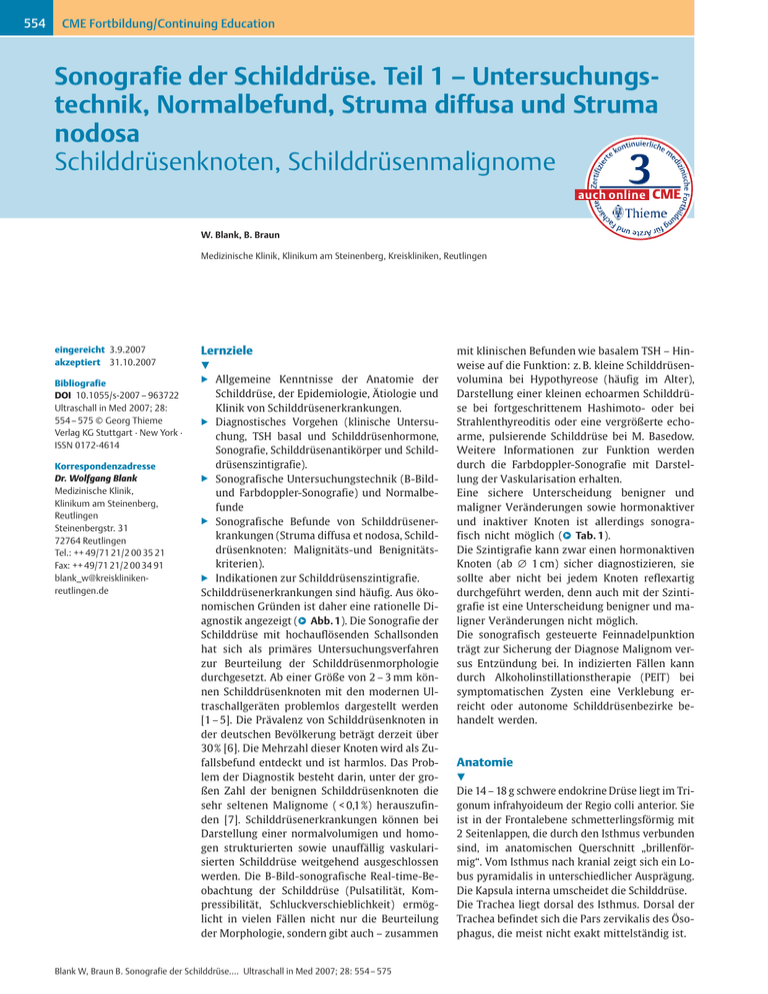
554 CME Fortbildung/Continuing Education Sonografie der Schilddrüse. Teil 1 – Untersuchungstechnik, Normalbefund, Struma diffusa und Struma nodosa Schilddrüsenknoten, Schilddrüsenmalignome W. Blank, B. Braun Medizinische Klinik, Klinikum am Steinenberg, Kreiskliniken, Reutlingen eingereicht 3.9.2007 akzeptiert 31.10.2007 Bibliografie DOI 10.1055/s-2007 – 963722 Ultraschall in Med 2007; 28: 554 – 575 © Georg Thieme Verlag KG Stuttgart · New York · ISSN 0172-4614 Korrespondenzadresse Dr. Wolfgang Blank Medizinische Klinik, Klinikum am Steinenberg, Reutlingen Steinenbergstr. 31 72764 Reutlingen Tel.: ++ 49/71 21/2 00 35 21 Fax: ++ 49/71 21/2 00 34 91 [email protected] Lernziele ! 왘 Allgemeine Kenntnisse der Anatomie der Schilddrüse, der Epidemiologie, Ätiologie und Klinik von Schilddrüsenerkrankungen. 왘 Diagnostisches Vorgehen (klinische Untersuchung, TSH basal und Schilddrüsenhormone, Sonografie, Schilddrüsenantikörper und Schilddrüsenszintigrafie). 왘 Sonografische Untersuchungstechnik (B-Bildund Farbdoppler-Sonografie) und Normalbefunde 왘 Sonografische Befunde von Schilddrüsenerkrankungen (Struma diffusa et nodosa, Schilddrüsenknoten: Malignitäts-und Benignitätskriterien). 왘 Indikationen zur Schilddrüsenszintigrafie. Schilddrüsenerkrankungen sind häufig. Aus ökonomischen Gründen ist daher eine rationelle Di" Abb. 1). Die Sonografie der agnostik angezeigt (● Schilddrüse mit hochauflösenden Schallsonden hat sich als primäres Untersuchungsverfahren zur Beurteilung der Schilddrüsenmorphologie durchgesetzt. Ab einer Größe von 2 – 3 mm können Schilddrüsenknoten mit den modernen Ultraschallgeräten problemlos dargestellt werden [1 – 5]. Die Prävalenz von Schilddrüsenknoten in der deutschen Bevölkerung beträgt derzeit über 30% [6]. Die Mehrzahl dieser Knoten wird als Zufallsbefund entdeckt und ist harmlos. Das Problem der Diagnostik besteht darin, unter der großen Zahl der benignen Schilddrüsenknoten die sehr seltenen Malignome ( < 0,1 %) herauszufinden [7]. Schilddrüsenerkrankungen können bei Darstellung einer normalvolumigen und homogen strukturierten sowie unauffällig vaskularisierten Schilddrüse weitgehend ausgeschlossen werden. Die B-Bild-sonografische Real-time-Beobachtung der Schilddrüse (Pulsatilität, Kompressibilität, Schluckverschieblichkeit) ermöglicht in vielen Fällen nicht nur die Beurteilung der Morphologie, sondern gibt auch – zusammen Blank W, Braun B. Sonografie der Schilddrüse.… Ultraschall in Med 2007; 28: 554 – 575 mit klinischen Befunden wie basalem TSH – Hinweise auf die Funktion: z. B. kleine Schilddrüsenvolumina bei Hypothyreose (häufig im Alter), Darstellung einer kleinen echoarmen Schilddrüse bei fortgeschrittenem Hashimoto- oder bei Strahlenthyreoditis oder eine vergrößerte echoarme, pulsierende Schilddrüse bei M. Basedow. Weitere Informationen zur Funktion werden durch die Farbdoppler-Sonografie mit Darstellung der Vaskularisation erhalten. Eine sichere Unterscheidung benigner und maligner Veränderungen sowie hormonaktiver und inaktiver Knoten ist allerdings sonogra" Tab. 1). fisch nicht möglich (● Die Szintigrafie kann zwar einen hormonaktiven Knoten (ab ∅ 1 cm) sicher diagnostizieren, sie sollte aber nicht bei jedem Knoten reflexartig durchgeführt werden, denn auch mit der Szintigrafie ist eine Unterscheidung benigner und maligner Veränderungen nicht möglich. Die sonografisch gesteuerte Feinnadelpunktion trägt zur Sicherung der Diagnose Malignom versus Entzündung bei. In indizierten Fällen kann durch Alkoholinstillationstherapie (PEIT) bei symptomatischen Zysten eine Verklebung erreicht oder autonome Schilddrüsenbezirke behandelt werden. Anatomie ! Die 14 – 18 g schwere endokrine Drüse liegt im Trigonum infrahyoideum der Regio colli anterior. Sie ist in der Frontalebene schmetterlingsförmig mit 2 Seitenlappen, die durch den Isthmus verbunden sind, im anatomischen Querschnitt „brillenförmig“. Vom Isthmus nach kranial zeigt sich ein Lobus pyramidalis in unterschiedlicher Ausprägung. Die Kapsula interna umscheidet die Schilddrüse. Die Trachea liegt dorsal des Isthmus. Dorsal der Trachea befindet sich die Pars zervikalis des Ösophagus, die meist nicht exakt mittelständig ist. CME Fortbildung/Continuing Education Sonography of the Thyroid – Part 1 W. Blank1, B. Braun2 1 2 Medizinische Klinik, Klinikum Reutlingen Medizinische Klinik, Klinikum am Steinenberg, Kreiskliniken Learning targets ! 왘 General knowledge of the anatomy of the thyroid and of the epidemiology, etiology, and diagnostics of thyroid diseases. 왘 Diagnostic procedure (clinical examination, basal TSH and thyroid hormones, sonography, thyroid antibody, and thyroid scintigraphy). 왘 Sonographic examination method (B-image and color Doppler sonography) and normal findings. 왘 Sonographic findings of thyroid diseases (Struma diffusa et nodosa, thyroid nodules: malignancy and benignity criteria) 왘 Indications for thyroid scintigraphy. For economic reasons, thyroid diseases are often displayed via economical diagnostic methods " Fig. 1). Sonography using high-resolution ul(● trasound transducers has become established as the leading examination method for assessing thyroid morphology. Starting at a size of 2 – 3 mm, thyroid nodules can be readily visualized with modern ultrasound devices [1 – 5]. The prevalence of thyroid nodules in the German population is currently greater than 30 % [6]. The majority of these nodules is discovered incidentally and is harmless. The diagnostic challenge is to identify the rare malignant tumors ( < 0.1 %) among the large number of benign thyroid nodules [7]. Thyroid diseases can be largely ruled out in the case of a normal-volume, homogeneously structured, and normally vascularized thyroid. B-image sonographic real-time observation of the thyroid (pulsatility, compressibility, shifting due to swallowing) makes it possible to evaluate the morphology in many cases and also provides information regarding function together with clinical findings such as basal TSH: for example small thyroid volumes in the case of hypothyroidism (often when older), representation of a small hypoechoic thyroid in the case of advanced Hashimoto's thyroi- ditis or radiation thyroiditis or an enlarged, hypoechoic, pulsating thyroid in M. Basedow. Further information regarding function is obtained via color Doppler sonography with vascularization visualization. However, reliable differentiation of benign and malignant changes as well as hormone-active and inactive nodules is not so" Table 1). Although nographically possible (● scintigraphy can reliably diagnose a hormoneactive nodule (greater than ∅ 1 cm), it should not automatically be performed for every nodule since benign and malignant changes cannot be differentiated with scintigraphy. Sonographically controlled fine-needle aspiration contributes to the reliability of the diagnosis of malignant tumors versus inflammation. In indicated cases, percutaneous ethanol injection therapy (PEIT) can be used to achieve coagulation of symptomatic cysts or to treat autonomous thyroid regions. Key words " thyroid ● " ultrasound ● " ultrasound color Doppler ● " fine-needle aspiration ● Anatomy ! The 14 – 18 g endocrine gland is in the Trigonum infrahyoideum of the regio colli anterior. It is butterfly-shaped on the frontal level with 2 side lobes connected by the isthmus and is “glasses-shaped” in the anatomical cross section. A lobus pyramidalis runs from the isthmus in a cranial direction. The capsula interna surrounds the thyroid. The trachea is dorsal to the isthmus. The pars cervicalis of the esophagus which is usually not exactly central is dorsal to the trachea. The thyroid is supplied with blood via the A. thyreoidea superior (branch of the carotis externa) running caudal to the upper thyroid pole to the front capsule and the A. thyreoidea inferior (from the Truncus thyreocervicalis) which is dorsal to the A. carotis communis to the lower thyroid pole. Venous discharge occurs via the vein plexus of the cap- Blank W, Braun B. Sonografie der Schilddrüse.… Ultraschall in Med 2007; 28: 554 – 575 555 556 CME Fortbildung/Continuing Education Tab. 1 Probleme der Schilddrüsensonografie Volumetrie bei großen Strumen retrosternale und intrathorakal gelegenes Schilddrüsengewebe Schilddrüsenfunktion nur indirekt beurteilbar (Durchblutung in der FDS, SD-Werte) – Autonomie in Knotenstruma – Differenzierung disseminierte Autonomie – Morbus Basedow – Differenzierung Morbus Basedow – Hashimoto-Thyreoiditis keine sicheren morphologischen Malignitätskriterien unzureichende Geräteausstattung Lateral der beiden Schilddrüsenlappen liegen die Halsgefäße (A. carotis und V. jugularis). Ventral der Schilddrüse findet sich die vordere Halsmuskulatur (M. sternothyreoideus und M. sternohyoideus, ventrolateral der M. sternocleidomastoideus, dorsal der prävertebrale M. longus colli, dorsolateral die Scalenusgruppe) " Abb. 2). (● unzureichende Ausbildung Technische Ausrüstung ! Abb. 1 Diagnostischer Weg bei Schilddrüsenerkrankungen. Fig. 1 Diagnostic path for thyroid diseases. Um bei der oberflächlichen Lage eine hohe Bildauflösung (1 – 2 mm) zu erreichen, sollten hochfrequente Schallsonden (7 – 14 MHz) eingesetzt werden. Bei großen nach retrosternal reichenden Strumen sind elektronisch umschaltbare Schallsonden (trapezförmig) oder Curved-array-Transducer sinnvoll. Harmonic imaging oder das sog. Sono-CT können die Kontrastierung mit reduzierter Artefaktbildung auch bei hochauflösenden Schallsonden verbessern. Mit der Panoramabilddarstellung lassen sich größere anatomische Regionen auch mit kleinen Transducern vollständig dokumentieren. Die Farbdoppler-Sonografie beantwortet wichtige klinische Fragestellungen: 왘 vaskuläre oder avaskuläre Raumfordrung, 왘 zystische oder solide (echoarme, vaskularisierte) Raumfordrung, 왘 Vaskularisationsgrad einer pathologischen Veränderung, 왘 Tumorinfiltration oder thrombotischer Verschluss von Halsgefäßen, 왘 Differenzierung von Schilddrüsenfunktionsstörungen. Die echosignalverstärkte Sonografie ist in der Zwischenzeit auch mit hochfrequenten Schallsonden möglich. Die Durchblutung der Schilddrüse kann noch sensitiver erfasst werden. Praktische Bedeutung hat die Methode in unserer Klinik nur in Einzelfällen zur Beurteilung des Therapieerfolges nach einer Ethanolinstillationstherapie (PEIT) autonomer Schilddrüsenknoten [8]. Abb. 2 Schilddrüse. Anatomie und Schnittführung. A. carotis communis (C), V. jugularis interna (J), Trachea (Tr), Isthmus (I), A. thyreoidea superior (Ts). Transversalschnitt (T), Longitudinalschnitt (L). Fig. 2 Thyroid. Anatomy and slice orientation A. carotis communis (C), V. jugularis interna (J), trachea (Tr), isthmus (I), A. thryreoidea superior (Ts), transverse section (T), longitudinal section (L). Untersuchungstechnik und Befunderhebung ! Die Gefäßversorgung der Schilddrüse erfolgt über die A. thyreoidea superior (Ast der Carotis externa), die nach kaudal zum oberen Schilddrüsenpol an die vordere Kapsel verläuft und die A. thyreoidea inferior (aus dem Truncus thyreozervikalis), die dorsal der A. carotis communis zum unteren Schilddrüsenpol zieht. Der venöse Abfluss erfolgt über den kräftigen Venenplexus der Kapsel in die V. jugularis internae und über die V. thyreoidea ima. Blank W, Braun B. Sonografie der Schilddrüse.… Ultraschall in Med 2007; 28: 554 – 575 Grundvoraussetzung ist die Kenntnis des sonografischen Normalbefunds, der mit einer ausgefeilten Untersuchungstechnik erstellt wird. Die Untersuchung erfolgt in Rückenlage des Patienten mit Unterpolsterung der Schulterblätter. Eine leichte Links- und Rechtsdrehung des Kopfes erleichtert die Darstellung der lateralen Halsregionen. Selten erfolgt eine Untersuchung im Sitzen zur Beurteilung der dorsalen Halsregion " Abb. 3). (● Zwei Untersucherpositionen sind möglich: Der Untersucher sitzt wie bei der Abdomensonogra- CME Fortbildung/Continuing Education sule in the V. jugularis interna and via the V. thyroidea ima. Lateral to the two thyroid lobes are the neck vessels (A. carotis and V. jugularis). Ventral to the thyroid is the front neck musculature (M. sternothyroideus and M. sternohyoideus, ventrolateral to the M. sternocleidomastoideus, dorsal to the prevertebral M. longus colli, dorsolateral to the scalenus group) " Fig. 2). (● Table 1 Problems of thyroid sonography volumetry of large strumas retrosternal and intrathoracic thyroid tissue thyroid function only indirectly assessable (blood flow in FDS, thyroid values) – autonomy in a nodular goiter – differentiation of disseminated autonomy – Morbus Basedow – differentiation of Morbus Basedow – Hashimoto thyroiditis no definitive morphological malignity criteria insufficient instrumentation insufficient training Technical equipment Abb. 3 Untersuchungstechnik. a Im Querschnitt. b Im Längsschnitt. Fig. 3 Examination method. a Transverse section. b Longitudinal section. ! To achieve high resolution (1 – 2 mm) in the case of a surface position, high-frequency ultrasound transducers (7 – 14 MHz) should be used. In the case of large struma extending retrosternally, electronically switchable ultrasound transducers (trapezoidal) or curved array transducers are useful. Harmonic imaging or sono CT can improve the contrast with reduced artifact formation even in the case of high-resolution ultrasound transducers. Large anatomical regions can be completely documented with panorama imaging even in the case of small transducers. Color Doppler sonography answers important clinical questions: 왘 vascular or avascular space-consuming lesion, 왘 cystic or solid (hypoechoic, vascularized) space-consuming lesion, 왘 degree of vascularization of a pathological change, 왘 tumor infiltration or thrombotic occlusion of neck vessels, 왘 differentiation of thyrotoxicosis. Echo signal-amplified sonography is now also possible with high-frequency ultrasound transducers. Blood flow in the thyroid can be recorded more accurately. This method has practical significance in our clinic only in individual cases for assessing therapy success after ethanol instillation therapy (PEIT) of autonomous thyroid nodules [8]. Examination method and recording of diagnostic findings ! The sonographic normal finding established with a sophisticated examination method must be known. The examination is performed with the patient in a dorsal position with support of the shoulder blades. Slight rotation of the head to the left and right facilitates visualization of the lateral neck regions. An examination for assessing the dorsal neck region is rarely performed " Fig. 3). in a sitting position (● Two examination positions are possible: the examiner sits next to the patient as in abdomen sonography or sits at the patient's head as in carotid Doppler examination. When recording diagnostic findings, in particular in the case of con- trols, a standardized equipment setting, examination method, and documentation including exact description of the sonographic finding are necessary. A space-consuming lesion is measured and photo-documented on two representative slice levels vertically over one another. Panorama imaging can be used to document larger anatomical regions and to better visualize the topographic relationships. Dynamic examination can be recorded via video documentation (time-intensive) or in the future via electronically savable video clips. Sonographic normal finding ! A normal thyroid has a smooth outer contour (capsule), and the structural pattern is homogeneously thick compared to hypoechoic musculature (M. sternocleidomastoideus). The capsule vessels can usually be visualized with Bimage sonography (improvement via Valsalva maneuver) but the intraglandular vessels are only visible with high-resolution transducers Blank W, Braun B. Sonografie der Schilddrüse.… Ultraschall in Med 2007; 28: 554 – 575 557 558 CME Fortbildung/Continuing Education Tab. 2 Normalwerte der Schilddrüsenvolumina bei mäßiger Jodversorgung Neugeborene < 1,5 ml 1- bis 4-Jährige < 3 ml 6- bis 10-Jährige < 4 ml 11- bis 14-Jährige < 8 ml Frauen < 18 ml Männer < 25 ml Tab. 3 Sonomorphologie diffuser und fokaler Schilddrüsenveränderungen diffuse Veränderungen fokale Veränderungen normale Binnenstruktur echofrei Struma diffusa parenchymatosa Zyste selten Morbus Basedow echoarme Binnenstruktur echoarm M. Basedow Adenom Hashimoto-Thyreoiditis maligner Tumor Postpartum-Thyreoiditis Einblutung, Abszess Thyreoiditis de Quervain (meist fokal) Thyreoiditis de Quervain echodichte Binnenstruktur echodicht Struma diffusa colloides Adenom Amyloidablagerung Fibrose, Kalk fie neben dem Patienten oder wie bei der Carotis-Doppler-Untersuchung am Kopf des Patienten. Zur Befunderhebung, insbesondere bei Verlaufskontrollen, sind eine standardisierte Geräteeinstellung, Untersuchungstechnik und Dokumentation einschließlich einer exakten Beschreibung des sonografischen Befundes notwendig. Eine Raumforderung wird in zwei repräsentativen senkrecht aufeinander stehenden Schnittebenen ausgemessen und fotodokumentiert. Mit der Panoramabilddarstellung können größere anatomische Regionen dokumentiert und die topografischen Beziehungen besser dargestellt werden. Die dynamische Untersuchung ist durch Video-Dokumentation (zeitaufwändiger) oder in Zukunft durch elektronisch speicherbare Videoclips erfassbar. Sonografischer Normalbefund ! Die normale Schilddrüse zeigt eine glatte Außenkontur (Kapsel), das Strukturmuster ist homogen dicht im Vergleich zur echoarmen Muskulatur (M. sternocleidomastoideus). Die Kapselgefäße sind B-Bild-sonografisch meist darstellbar (Verbesserung durch Valsalvamanöver), die intraglandulären Gefäße nur mit hochauflö" Abb. 4, 5). senden Sonden erkennbar (● Mit der Farbdoppler-Sonografie sind die zu- und abführenden und die intraglandulären Gefäße abgrenzbar. Sie liefert damit wichtige Zusatzinformationen zur Durchblutung und indirekt zur Funktion. Trotz standardisierter Geräteeinstellung bleibt die Beurteilung subjektiv (semiquantitative Information). Der „Normalbefund“ ist außerdem schallkopf- und geräteabhängig. Jeder Blank W, Braun B. Sonografie der Schilddrüse.… Ultraschall in Med 2007; 28: 554 – 575 Untersucher muss seine „Normalbefunde“ mit seinem Gerät kennen. Durch die Duplexsonografie können quantitative Informationen erhalten werden. Bestimmt wird die maximale systolische Geschwindigkeit (Peak Systolic Velocity, PSV) in den zuführenden Arterien (A. thyreoidea inferior oder superior) deren Normalwerte liegen zwischen 20 und 40(50) cm/s. In der Differenzialdiagnose der Hyperthyreose kann die Bestimmung der PSV weiterhelfen. Die von italienischen Autoren empfohlene intraglanduläre Messung ist sehr störanfällig und noch nicht ausreichend validiert. Empfohlen werden kleine Messtore (2 – 3 mm) und wegen eingeschränkter Winkelkorrektur jeweils 3 Messungen. Die PSV-Normalwerte sind sehr variabel (3 – 10 cm), abhängig vom Messort und " Abb. 6) [1, 9]. auch vom Normalkollektiv (● Dorsomedial der linken Schilddrüse zeigen sich unter leichter lateraler Kippung der Schallsonde die zervikalen Anteile des Ösophagus. Beim Schluckakt bewegt sich die Schilddrüse kranialwärts, der Ablauf der peristaltischen Welle durch den Ösophagus kann beobachtet werden " Abb. 5a). (● Die Volumenschätzung erfolgt nach der Näherungsformel Länge × Breite × Tiefe × 0,5 Die Volumina beider Schilddrüsenlappen und des Isthmus werden addiert. Das Volumen des Isthmus wird nach dergleichen Nährungsformel berechnet. Bei der Messung beträgt die Interobservervariation 3 – 13 %. Auch die „Normalmaße“ variieren stark (Breite 1 – 3 cm, Tiefe 1 – 1,7 cm, Länge 4 – 7 cm). Entscheidend sind die Volumi" Tab. 2). na, nicht die Einzelmaße (● Differenzialdiagnose sonografischer Schilddrüsenveränderungen ! Eine Schilddrüsenerkrankung kann bei sonografischem Normalbefund mit hoher Sicherheit ausgeschlossen werden. Diffuse und fokale Schilddrüsenveränderungen können anhand ihrer Echogenität differenziert werden. Das Echomuster wird bei fokalen Veränderungen mit dem normalem Schilddrüsengewebe, bei diffusen Veränderungen mit der Halsmuskulatur (M. sternocleidomastoideus) vergli" Tab. 3). chen (● Die B-Bild-sonografische Real-time-Beobachtung der Schilddrüse (Pulsatilität, Kompressibilität, Schluckverschieblichkeit) ermöglicht in vielen Fällen nicht nur die Beurteilung der Morphologie, sondern gibt auch – zusammen mit klinischen Befunden wie basalem TSH – Hinweise auf die Funktion.: z. B. kleine SD-Volumen bei Hypothyreose (häufig im Alter!), Darstellung einer kleinen echoarmen Schilddrüse bei fortgeschrittener Hashimoto- oder bei Strahlenthyreoiditis oder ferner eine vergrößerte, echoarme, pulsierende CME Fortbildung/Continuing Education " Fig. 4, 5). The afferent, efferent, and intra(● glandular vessels can be delimited with color Doppler sonography. It therefore provides important additional information regarding blood flow and indirectly regarding function. Despite a standardized equipment setting, assessment is subjective (semi-quantitative information). The “normal finding” also depends on the probe and equipment. Every examiner must be familiar with the “normal values” for a particular device. Duplex sonography can be used to obtain quantitative information. The peak systolic velocity (PSV) is determined in afferent arteries (A. thyreoidea inferior or superior) whose normal values are between 20 and 40 (50) cm/sec. Determination of the PSV can be helpful for differential diagnosis of hyperthyrosis. The intraglandular measurement recommended by Italian authors is prone to problems and has not been sufficiently validated. Small measuring ports (2 – 3 mm) and 3 measurements in each case due to the limited angle correction are recommended. The PSV normal values are very variable (3 – 10 cm), depending on the measure" Fig. 6) [1, ment site and the normal collective (● 9]. A slight lateral tilt of the transducer shows the cervical parts of the esophagus dorsomedial to the left thyroid. When swallowing, the thyroid moves towards the cranium and the peristaltic wave through the esophagus can be ob" Fig. 5a). served (● The volume is estimated according to the approximation formula Length × width × depth × 0.5 The volume of both thyroid lobes and the isthmus are added. The volume of the isthmus is calculated according to the same approximation formula. The interobserver variation is 3 – 13 % for the measurement. The “normal dimensions” also vary greatly (width 1 – 3 cm, depth 1 – 1.7 cm, length 4 – 7 cm). The volumes, not " Tathe individual dimensions, are decisive (● ble 2). Differential diagnosis of sonographic thyroid changes ! A thyroid disease can be ruled out with a high degree of reliability in the case of a sonographic normal finding. Diffuse and focal thyroid changes can be differentiated on the basis of their echogenicity. The echo pattern is compared to the normal thyroid tissue in the case of focal changes and to the neck musculature (M. sternocleidomastoideus) in the case " Table 3). B-image sonoof diffuse changes (● graphic real-time observation of the thyroid (pulsatility, compressibility, shifting due to swallowing) makes it possible to evaluate the morpholo- Table 2 Normal thyroid volumes for moderate iodine supply newborn 1 – 4 years old < 1.5 ml < 3 ml 6 – 10 years old < 4 ml 11 – 14 years old < 8 ml women < 18 ml men < 25 ml Table 3 Sonomorphology of diffuse and focal thyroid changes diffuse changes focal changes normal internal structure anechoic struma diffusa parenchymatosa cysts rare Morbus Basedow hypoechoic internal structure hypoechoic M. Basedow adenoma Hashimoto thyroiditis malignant tumor Postpartum thyroiditis hemorrhage, abscess thyroiditis de Quervain (usually focal) thyroiditis de Quervain echodense internal structure echodense struma diffusa colloides adenoma amyloid deposit fibrosis, calcification Abb. 4 Normalbefund. a Querschnitt beider Schilddrüsenlappen in Isthmushöhe. Harmonic imaging (THI), Trachea. M. sternocleidomastoideus (M. sc.), A. carotis interna (ACC). Fig. 4 Normal result. a Transverse section of both thyroid lobes on the level of the isthmus. Harmonic imaging (THI), trachea. M. sternocleidomastoideus (M. sc.), A. carotis interna (ACC). gy in many cases and also provides information regarding function together with clinical findings such as basal TSH: for example small thyroid volumes in the case of hypothyroidism (often when older), representation of a small hypoechoic thyroid in the case of advanced Hashimoto's thyroiditis or radiation thyroiditis or an enlarged, hypoechoic, pulsating thyroid in M. Basedow. Color Doppler sonography provides further information regarding function by visualizing the blood flow. The sensitivity of color Doppler sonography has increased greatly over the last several years due to improved equipment technology. However, the specificity (differentiation of benign and malignant modules, hormone-active and inactive nodules) is not sufficient. The assignment of sonographically recorded pathological findings to the various diseases thus requires additional information from the patient history, clinical diagnosis, and lab values and is largely dependent on the experience of the examiner. Sonographically targeted fine-needle aspiration can be necessary for diagnosis verification. Blank W, Braun B. Sonografie der Schilddrüse.… Ultraschall in Med 2007; 28: 554 – 575 559 560 CME Fortbildung/Continuing Education Abb. 5 Normalbefund. a Querschnitt des linken Schilddrüsenlappens (Kreuze). Strukturmuster homogen dicht im Vergleich zur echoarmen Muskulatur. M. sternocleido mastoideus (M. sc.), M. sternothyreoideus (M. st.), M. sternohyoideus (M. SH), M. longus colli (M. lc.), Trachea (TR), A. carotis communis (ACC), V. jugularis interna (VJI). b Längsschnitt über kleinem Lobus pyramidalis (zwischen Pfeile cranial des Isthmus). c Längsschnitt des linken Schilddrüsenlappens. Harmonic imaging (THI) ventral echoarmer Muskel. Halswirbelkörper (HWK). Volumenmessung linker Schilddrüsenlappen. V = 1/2 × Länge (5 cm) × Breite (1,9 cm) × Tiefe (1,6 cm) = 7,6 ml. Fig. 5 Normal result. a Transverse section of the left thyroid lobe (crosses). Structural pattern homogeneously thick compared to hypoechoic musculature. M. sternocleidomastoideus (M. sc.), M. sternothyreoideus (M. st.), M. sternohyoideus (M. SH), M. longus colli (M. lc.), trachea (TR), A. carotis communis (ACC), V. jugularis interna (VJI). b Longitudinal section over small lobus pyramidalis (between arrows cranial to the isthmus). c Longitudinal section of the left thyroid lobe. Harmonic imaging (THI) ventral hypoechoic muscle. Cervical vertebra (HWK). Volume measurement of left thyroid lobe. V = 1/2 × length (5 cm) × width (1.9 cm) × depth (1.6 cm) = 7.6 ml. Schilddrüse bei M. Basedow. Weitere Informationen zur Funktion werden durch die FarbdopplerSonografie mit der Darstellung der Durchblutung erzielt. Die Sensitivität der Farbdopplersonografie ist durch verbesserte Gerätetechnik in den letzten Jahren deutlich gestiegen. Die Spezifität (Unterscheidung benigne – maligne, hormonaktive – inaktive Knoten) ist jedoch nicht ausreichend. Die Zuordnung sonografisch erhobener pathologischer Befunde zu den unterschiedlichen Krankheitsbildern erfordert deshalb Zusatzinformationen aus Anamnese, klinischem Befund und Laborwerten und ist wesentlich abhängig von der Erfahrung des Untersuchers. Zur endgültigen Diagnosesicherung kann die sonografisch gezielte Feinnadelpunktion notwendig sein. Schilddrüsenerkrankungen ! Struma Die Struma ist definiert als Organvergrößerung. Hauptursache ist ein alimentärer Jodmangel. Seltener sind eine Schilddrüsenvergrößerung bei Hyperthyreose, Entzündungen und Tumoren zu finden. Die Struma diffusa ist die häufigste Schilddrüsenerkrankung. Sie manifestiert sich bei Jugendlichen und im jungen Erwachsenenalter (Prävalenz in Deutschland 10 – 20% der 20- bis 30-Jährigen). In Endemiegebieten ist alimentärer Jodmangel die Hauptursache [10, 11]. Leitsymptome sind Druckgefühl, „dicker“ Hals, Schluckstörungen, Dyspnoe und Hustenreiz. Die palpatorisch vergrößerte Schilddrüse ist weich, die Schilddrüsenfunktion ist normal (normales basales TSH). Sonografisch ist die vergrößerte Schilddrüse glatt begrenzt, das Strukturmuster ist homogen dicht Blank W, Braun B. Sonografie der Schilddrüse.… Ultraschall in Med 2007; 28: 554 – 575 oder leicht echogenitätsvermehrt (Struma diffu" Abb. 7). sa coloides) (● Differenzialdiagnostisch sind ein echogener Morbus Basedow (vermehrte Durchblutung, erhöhte PSV = maximale systolische Geschwindigkeit) und eine diffuse Amyloidablagerung in der Schilddrüse (vergrößerte, vermehrt echogene Schilddrüse) abzugrenzen. Sind sonografisch knotige Schilddrüsenveränderungen ausgeschlossen und liegt der TSH-Spiegel im Normbereich, werden Jod und/oder Schilddrüsenhormone substituiert. Nach einem Jahr erfolgt eine Kontrollsonografie. Bei länger bestehendem Jodmangel kann sich bei genetischer Disposition nach Jahren eine Struma nodosa entwickeln mit multiplen Knotenbildungen (knotige Hyperplasie, echte Adenome) und regressiven Veränderungen (zystische Degeneration, Fibrosierungen und Verkalkungen). Die Größenzunahme kann beträchtlich sein. Durch lokale Verdrängung kommt es zunächst zur Verlagerung von Trachea und/oder Ösophagus, später resultiert eine obere Einflussstauung. Sonografisch ist die Organkontur unverändert glatt begrenzt mit knotigen Vorwölbungen " Abb. 8). Retrosternale Anteile können mit (● angulierten Schnittführungen mit sektorförmigen Schallsonden erfasst werden. Zur Organausmessung und Dokumentation sind niederfrequente Schallsonden (5 MHz) mit größerer, evtl. gebogener Auflagefläche günstig. Vorteile bieten moderne Schallsonden mit elektronischer Umschaltmöglichkeit zu einem trapezförmigem " Abb. 4). Die Volumenbestimmung wird Bild (● mit zunehmender Größe von Schilddrüse und Knoten und bei größeren retrosternalen Anteilen ungenauer. Große Strumen sind mit zusammengesetztem Bild oder besser in Panoramatechnik exakt zu vermessen, wenn die Schild- CME Fortbildung/Continuing Education Thyroid diseases ! Struma Struma is defined as organ enlargement. The main cause is an alimentary iodine deficiency. Less common is a thyroid enlargement in the case of hyperthyrosis, inflammations, and tumors. Struma diffusa is the most common thyroid disease. It manifests in juveniles and young adults (prevalence in Germany 10 – 20% of 20 – 30 year olds). In endemic areas, alimentary iodine deficiency is the main cause [10, 11]. The main symptoms are pressure, “thick” throat, problems swallowing, dyspnea, and a tickle in the throat. The enlarged thyroid is soft to the touch and thyroid function is normal (normal basal TSH). Sonographically the enlarged thyroid has a smooth contour and the structure pattern is homogeneously thick or with slightly increased echogenicity " Fig. 7). An echo(struma diffusa coloides) (● genic Morbus Basedow (increased blood flow, increased PSV = maximum systolic velocity) and diffuse Amyloid deposit in the thyroid (enlarged thyroid with increased echogenicity) can be differentiated via differential diagnostics. If knotty thyroid changes are ruled out sonographically and the TSH level is normal, iodine and/or thyroid hormones can be substituted. Control sonography is performed after one year. Given a genetic disposition, a struma nodosa can develop after years of iodine deficiency with the formation of multiple nodules (knotty hyperplasia, real adenoma) and regressive changes (cystic degeneration, fibrosis, and calcifications). The increase in size can be considerable. Local displacement results first in shifting of the trachea and/or esophagus and later in venous congestion. Sonographically, the organ contour continues to be smooth and is bordered by knotty protrusions " Fig. 8). Retrosternal segments can be recorded (● with angled slice orientation via sector-forming ultrasound transducers. Low-frequency ultrasound transducers (5 MHz) with a large, possibly curved, bearing surface are useful for organ measuring and documentation. Modern ultrasound transducers with an electronic switching option " Fig. 4) are advantafor a trapezoidal image (● geous. Volume determination accuracy decreases as the thyroid and nodule size increases and in the case of larger retrosternal segments. Large struma can be exactly measured with a composite image or ideally with a panorama technique when the thyroid length exceeds the dimension of the transducer. Thyroid nodules The prevalence of palpable nodules is 20 – 30% and the percentage of nodes currently identified sonographically is 50 – 70% [6, 12]. Thyroid nodes have high echo diversity: with respect to the surrounding thyroid parenchyma, they can Abb. 6 a A. thyreoidea superior. Normalbefund. Die A. thyr. sup. verläuft nach Abgang aus der Carotis externa kaudal zum oberen Schilddrüsenpol und lässt sich dorsal an der vorderen Kapsel farbdoppler-sonografisch abgrenzen. Die maximale systolische Geschwindigkeit (peak systolic velocity, PSV) wird bestimmt. PSV = 16,8 cm/s. b A thyreoida inferior. Normalbefund. Die A. thyr. Inf. entspringt aus dem Truncus thyreocervicalis (3. Ast aus der A. subclavia), wendet sich nach medial und unterkreuzt (Pfeil) in Höhe des 6. Halswirbels die A. carotis communis (ACC) und erreicht die Schilddrüse am unteren Pol. c Intraglanduläre Gefäße. Normalbefund. a Die Untersuchung erfolgt im klassischen Farbdopplermodus oder wie im vorliegenden Fall im Powermodus. Trachea (Tr), M. sternocleidomastoideus (M.sc.), A. carotis communis (ACC). d Im Dopplermodus auf den Schallkopf zulaufendes Gefäß, das duplexsonografisch sicher als Arterie beurteilt werden kann. Die PSV liegt bei 15 cm/s. Fig. 6 a A. thyreoidea superior. Normal result. The A. thyr. sup. leaves the carotis externa, runs caudal to the top thyroid pole and can be dorsally delimited at the front capsule via color Doppler sonography. The maximum systolic velocity (peak systolic velocity, PSV) is determined. PSV = 16.8 cm/sec. b A. thyreoidea inferior. Normal result. The A. thyr. inf. originates from the truncus thyreocervicalis (3 rd branch from the A. subclavia), turns in a medial direction, crosses under (arrow) the A. carotis communis (ACC) at the 6th cervical vertebra, and reaches the thyroid at the lower pole. c Intraglandular vessels. Normal result. a Examination is performed in the standard color Doppler mode or in the power mode as in the present case. Trachea (Tr), M. sternocleidomastoideus (M. sc.), A. carotis communis (ACC). d Vessel running up to the probe in the Doppler mode, can be reliably identified as an artery via duplex sonography. The PSV is 15 cm/ sec. be more hypoechoic, echo-identical, or more hyperechoic. Mix types are common. Regressive changes that also occur in normal-sized thyroids result additionally in inhomogeneous sonographic image. Cystic degeneration is manifested as anechoic, partially irregularly bordered, formations with distal sound amplification. Hemorrhages result in echogenic septations and clots can appear solid. With color Doppler sonography, such regions are differentiated from solid structures by the lack of vascularization. A cystically collapsed adenoma must be delimited from this. Fibrosis and calcifications are sonomorphologically shown as hyperechoic structures with dorsal acoustic shadow formation in some cases. Malignity risk The diagnostic challenge is to identify rare malignant cases among the large number of benign Blank W, Braun B. Sonografie der Schilddrüse.… Ultraschall in Med 2007; 28: 554 – 575 561 562 CME Fortbildung/Continuing Education soliden Strukturen zu unterscheiden. Davon abzugrenzen ist ein zystisch zerfallenes Adenom. Fibrosierungen und Verkalkungen stellen sich sonomorphologisch als echodichte Strukturen teils mit dorsaler Schallschattenbildung dar. Malignitätsrisiko Abb. 7 Struma diffusa (parenchymatosa). a Querschnitt des vergrößerten rechten Schilddrüsenlappens mit normaler Echotextur (Vergleich mit echoarmer Muskulatur). b Längsschnitt über rechtem Schilddrüsenlappen. 13-mHz-Schallsonde mit trapezförmigem Bild, damit vollständige Organdokumentation möglich. Volumen: 25,8 ml = 1/ 2 × Länge (6 cm) × Breite (3,2 cm) × Tiefe (2,4 cm). Fig. 7 Struma diffusa (parenchymatosa). a Transverse section of the enlarged right thyroid lobe with normal echotexture (compared to hypoechoic musculature). b Longitudinal section over the right thyroid lobe. 13 mHz ultrasound transducer with trapezoidal image to allow complete organ documentation. Volume: 25.8 ml = 1/2 × length (6 cm) × width (3.2 cm) × depth (2.4 cm). Abb. 8 Struma nodosa. a Querschnitt des rechten vergrößerten Schilddrüsenlappens (Breite 2,1 cm). Inhomogenes Strukturmuster mit multiplen regressiv imponierenden Knoten (Pfeile). Punktion ist nicht notwendig. Verlaufssonografie in 6 Monaten. b Längsschnitt rechter Schilddrüsenlappen. Durch Panoramabilddarstellung (Sie-Scape, Fa. Siemens) ist eine vollständige Abbildung des vergrößerten rechten Schilddrüsenlappens (7,85 cm) möglich. Multiple, teils zystisch zerfallende echogleiche und echoreichere Knoten mit Maximaldurchmesser 5,5 cm. Fig. 8 Struma nodosa. a Transverse section of the enlarged right thyroid lobe (width 2.1 cm). Inhomogeneous structural pattern with multiple regressive-appearing nodules (arrows). Puncture is not necessary. Sonography to monitor progress in 6 months. b Longitudinal section of the right thyroid lobe. Panorama imaging (Sie-Scape, Siemens) allows complete visualization of the enlarged right thyroid lobe (7.85 cm). Multiple echo-identical and hyperechoic nodules, some with cystic collapse, with a maximum diameter of 5.5 cm. drüsenlänge die Abmessung der Transducer überschreitet. Schilddrüsenknoten Die Prävalenz der palpablen Knoten liegt bei 20 – 30%, die heute sonografisch gefundenen Knoten bei 50 – 70% [6, 12]. Schilddrüsenknoten zeigen eine große Echovielfalt: Sie können echoärmer, echogleich oder echoreicher als das umgebende Schilddrüsenparenchym sein, häufig sind Mischtypen. Durch regressive Veränderungen, die auch in normal großen Schilddrüsen zu finden sind, entsteht zusätzlich ein inhomogenes sonografisches Bild. Zystische Degenerationen zeigen sich als echofreie, teils unregelmäßig begrenzte Formationen mit distaler Schallverstärkung. Einblutungen führen zu echogenen Septierungen, Koagel können solide imponieren. Farbdopplersonografisch sind solche Bezirke durch die fehlende Vaskularisation von Blank W, Braun B. Sonografie der Schilddrüse.… Ultraschall in Med 2007; 28: 554 – 575 Das Problem der Diagnostik besteht darin, unter der großen Zahl der benignen Schilddrüsenknoten die seltenen Malignome herauszufinden. Die Sonografie liefert dazu wichtige Bausteine. Es gibt zwar keine sicheren sonografischen Malignitätskriterien, jedoch weisen bestimmte Merkmale (Echointensität, Echoverteilung, Umgebunsbegrenzung) auf die Dignität eines Knotens hin und erlauben eine „Risiko" Abb. 10, 11). stratifizierung“ (● Knoten mit homogenem echofreiem, echogleichem oder echoreicherem Reflexmuster haben ein extrem niedriges Karzinomrisiko. Eine Feinnadelpunktion ist hier nur bei einem erhöhten Risikoprofil für ein Schilddrüsenkarzinom notwendig (positive Familienanamnese, lokale Bestrahlung, Alter < 30 Jahre, tastbarer Solitärknoten, sonografische Malignitätskriterien, wie unscharfe Begrenzung und inkompletter Randsaum). Knoten mit einem echoarmen Reflexmuster haben ein deutlich höheres Karzinomrisiko. Liegen bei erhöhtem Risikoprofil sonografische Maligni" Tab. 3) vor, ist ein Malignom tätskriterien (● wahrscheinlich. Bei echoarmen Knoten > 8 mm sollte die Indikation zur Feinnadelpunktion großzügig gestellt werden. Knoten < 8 mm sollten sonografisch beobachtet werden, eine Verlaufssonografie alle (6–)12 Monate ist ausreichend. Ein vollständiger echoarmer oder echofreier Randsaum in mehreren Schnittebenen ist dagegen ein relativ sicheres Benignitätskriterium " Tab. 4), (● " Abb. 11) [13 – 19]. (● Knoten werden in 3 Ebenen vermessen, topografisch zugeordnet und dokumentiert. Klinische Vorgehensweise bei einer Knotenstruma Nur ca. 20% aller Patienten mit einer Knotenstruma benötigen eine operative Therapie. Eine abwartende Haltung mit Verlaufssonografie alle 6 – 12 Monate ist berechtigt bei 왘 negativer Familienanamnese für ein SD-Karzinom, 왘 fehlender Bestrahlung der Halsregion, 왘 einer Knotengröße < 15 mm, " Tab. 4). 왘 fehlenden Malignitätskriterien (● „Dominante“ Knoten (größer 15 mm, auffällig) werden genau inspiziert und nach den unten ge" Tab. 4) beurteilt. nannten Malignitätskriterien (● Suspekte Knoten sollten diagnostisch punktiert werden oder bei eindeutigen Malignitätskriterien der Operation zugeführt werden. CME Fortbildung/Continuing Education thyroid nodules. Sonography provides important information. Although there are no reliable sonographic malignity criteria, certain features (echo intensity, echo distribution, contour) indicate the nature of a nodule and allow “risk stratification” " Fig. 10, 11): nodules with a homogeneous an(● echoic, echo-identical, or hyperechoic reflex pattern have an extremely low risk of carcinoma. Fine-needle aspiration is only necessary for an increased risk profile for thyroid carcinomas (positive family history, local radiation, older than 30, palpable solitary nodule, sonographic malignity criteria, such as poorly defined contour and incomplete edge). Nodules with a hypoechoic reflex pattern have a significantly higher risk of carcinoma. In the case of sonographic malignity " Table 3), criteria and an increased risk profile (● a malignant tumor is probable. In the case of hypoechoic nodules > 8 mm, the indication for fineneedle aspiration should be generous. Nodules < 8 mm should be sonographically monitored. Sonographic monitoring every 6 – 12 months is sufficient. However, a complete hypoechoic or anechoic edge on several slice levels is a relative" Table 4), ly reliable benignity criterion (● " (● Fig. 11), [13 – 19]. Nodules are measured on 3 levels, are topographically assigned, and are documented. Clinical procedure for nodular goiters Only approx. 20% of all patients with a nodular goiter require surgery. A wait-and-see attitude with sonographic monitoring every 6 – 12 months is justified for 왘 negative family history for a thyroid carcinoma, 왘 lack of radiation of the neck region, 왘 nodule size < 15 mm, " Table 4). 왘 lack of malignity criteria (● “Dominant” nodules (greater than 15 mm, noticeable) are inspected closely and evaluated according to the malignity criteria indicated be" Table 4). Suspicious nodules should be low (● diagnostically punctured or surgically treated if malignant! Thyroid cysts These are primarily pseudocysts with regressive changes. Real epithelial cysts in the thyroid are rare. Cysts are usually found incidentally, or sometimes as “acute thyroid cysts” with pain " Fig. 9). These are sonographiand swelling (● cally shown as anechoic regions that have a round or oval shape and a smooth border, range from 2 mm to several cm, and sometimes have echogenic septations. New hemorrhages result in internal echoes that can simulate hypoechoic tumors in the case of small cysts. Color Doppler sonography typically does not show blood flow so that hypoechoic tumors (e. g. lymphoma) and also cystically collapsing nodules (hormone-active and hormone-inactive adenomas) can be differentiated. Cystically collapsing autonomous adenomas can be identified by verification of a hypoechoic vascularized edge. If the findings are unclear, fine-needle aspiration is indicated. In the case of acute hemorrhage, suctioning of the cyst contents alleviates pain. Thyroid adenomas Thyroid adenomas are new epithelial formations in contrast to reactive adenomatous nodules in the case of struma nodosa. Follicular adenomas are usually solitarily. Adenomas have a capsule and therefore have a smooth contour with respect to the surroundings. Endocrine active autonomous adenomas (scintigraphically identified hyperfunctional, hot) are significantly more common than endocrine inactive autonomous adenomas (scintigraphically identified hypofunctional nodules). Adenomas songraphically show a homogeneous structural pattern. Microfollicular adenomas are typically hypoechoic, normofollicular adenomas are typically echoidentical, and macrofollicular adenomas are usually hyperechoic. Thyroid adenomas typically have a complete hypoechoic or anechoic edge which, as shown via color Doppler sonography, is formed by vessels running annularly (therefore should not be called “halo”). A complete edge is considered to be a sign of benignity " Fig. 11). (● Endocrine active ( = autonomous) adenomas have increased edge and internal vascularization but this can also be the case in other adenomas and malignant thyroid tumors. In contrast, regressive thyroid nodules usually only show edge vascularization. Scintigraphy is used to verify autonomous regions, but nodules smaller than 1 cm often cannot be verified even via suppression scintigraphy due to the lower local resolution compared to that of sonography. However, not every sonographically verified nodule (incidentaloma) should undergo scintigraphy. Color Doppler sonography provides a link between morphology and function in many cases. Increased perfusion in the node interior combined with a suppressed basal TSH statistically indicates a greater probability of autonomy. The important but rare differential Abb. 9 Schilddrüsenzyste. Klinisch Schwellung, akuter Schmerz. Sonografisch weitgehend echofreier Knoten mit unter Palpation sich bewegenden Binnenechos. Im Randbereich (Pfeile) solid imponierende echoarme Randstrukturen darstellbar. Farbdopplersonografisch weder zentral noch in den soliden Arealen Durchblutung detektierbar. Wegen Spannungsgefühl Abpunktion unter kontinuierlicher sonografischer Kontrolle. Aspirationszytologie der soliden Anteile. Zytologisch: kein Malignitätshinweis. Fig. 9 Thyroid cysts. Clinical swelling, acute pain. Largely sonografically anechoic nodules with moving internal echoes under palpation. Solid-appearing hypoechoic edge structures visualizable in the edge region (arrows). Blood flow not detectable centrally or in the solid areas via color Doppler sonography. Draining performed under continuous sonografic control dueto feeling of tension. Aspiration cytology of solid segments. Cytologically: no malignity indication. Blank W, Braun B. Sonografie der Schilddrüse.… Ultraschall in Med 2007; 28: 554 – 575 563 564 CME Fortbildung/Continuing Education Schilddrüsenzysten Vorwiegend handelt es sich um Pseudozysten durch regressive Veränderungen. Echte, mit Epithel ausgekleidete Zysten sind in der Schilddrüse selten. Die Zysten werden meist zufällig gefunden, manchmal auch als „akute Schilddrüsenzys" Abb. 9). ten“ bei Schmerzen und Schwellung (● Sonografisch zeigen sich 2 mm bis mehrere cm große rundlich bis ovale, glatt begrenzte echofreie Bezirke, teils mit echogenen Septenbildungen. Frische Einblutungen führen zu Binnenechos, die bei kleinen Zysten echoarme Tumoren vortäuschen können. Farbdopplersonografisch ist typischerweise keine Durchblutung detektierbar, sodass ausgeprägt echoarme Tumoren (z. B. Lymphome) und auch zystisch zerfallende Knoten (hormon- und nicht hormonaktive Adenome) differenziert werden können. Zystisch zerfallende autonome Adenome können durch Nachweis eines echoarmen vaskularisierten Randsaumes erkannt werden. Bei unklarem Befund ist eine Feinnadelpunktion indiziert. Bei einer akuten Einblutung führt das Absaugen des Zysteninhalts zur Schmerzfreiheit. Schilddrüsenadenome Schilddrüsenadenome sind epitheliale Neubildungen im Gegensatz zu den reaktiven adenomatösen Knoten bei Knotenstrumen. Follikuläre Adenome treten meist solitär auf. Adenome haben eine Kapsel, sind also gegenüber der Umgebung glatt abgegrenzt. Endokrin aktive autonome Adenome (szintigrafisch hyperfunktionell, heiß) sind wesentlich häufiger als endokrin nicht aktive autonome Adenome (szintigrafisch hypofunktionelle Knoten). Sonografisch zeigen Adenome ein homogenes Strukturmuster. In der Regel sind mikrofollikuläre Adenome meist echoarm, normofollikuläre Adenome meist echogleich und makrofollikuläre Adenome meist echoreich. Schilddrüsenadenome zeigen typischersweise einen vollständigen echoarmen oder echofreien Randsaum, der, wie sich farbdopplersonografisch nachweisen lässt, durch ringförmig verlaufende Gefäße entsteht (sollte daher nicht „Halo“ genannt werden). Ein vollständiger Randsaum " Abb. 11)! Endogilt als Benignitätszeichen (● krin aktive ( = autonome) Adenome haben darüberhinaus eine vermehrte Rand- und Binnenvaskularisation, wie sie allerdings auch bei anderen Adenomen und malignen Schilddrüsentumoren zu finden ist. Demgegenüber lassen regressive Schilddrüsenknoten meist nur eine Randvaskularisation erkennen. Die Szintigrafie dient der Sicherung autonomer Bezirke, wobei Knoten kleiner 1 cm wegen der im Vergleich zur Sonografie schlechteren Ortsauflösung auch mittels Suppressionsszintigrafie nicht immer nachgewiesen werden können. Nicht jeder sonografisch nachgewiesene Knoten (Inzidentalom) sollte jedoch ergänzend szinti- Blank W, Braun B. Sonografie der Schilddrüse.… Ultraschall in Med 2007; 28: 554 – 575 grafiert werden. Die Farbdoppler-Sonografie bietet sich als Bindeglied zwischen Morphologie und Funktion in vielen Fällen an. Eine erhöhte Perfusion im Knoteninneren kombiniert mit einem supprimierten TSH basal weist statistisch in hoher Wahrscheinlichkeit auf eine Autonomie hin. Die wichtige, aber seltene Differenzialdiagnose eines ebenfalls vaskularisierten Schilddrüsenmalignoms wird gegebenenfalls durch die sonografisch gesteuerte Feinnadelpunktion gesichert. In der Diagnostik des seltenen Schilddrüsenmalignoms wird die Schilddrüsenszintigrafie maßlos überschätzt. Szintigrafisch hypofunktionelle (kalte) Knoten wurden in ihrer Bedeutung in der „Vorsonografieära“ sicher überbewertet. Meist handelt es sich um benigne Formationen, nur ca. 1 % aller szintigrafisch entdeckten hypofuntionellen Knoten sind maligne. Wurde primär szintigrafiert und dabei ein hypofunktioneller Knoten entdeckt, erfolgt eine ergänzende Ultraschalluntersuchung zur Evaluierung des Knotens (siehe Risikoabschätzung für Malignität). Suspekt sind hypofunktionelle echoarme solitäre Knoten, die eine unscharfe Begrenzung und/oder Mikrokalk und/oder eine zentrale Durchblutung aufweisen. Diese Knoten ( > 1 cm) werden diagnostisch punktiert oder verlaufsbeobachtet ( < 1 cm). Wird die Sonografie als erstes bildgebendes Verfahren eingesetzt, kann bei Knoten unter einer Größe von 1,5 cm bei supprimierten und auch bei normwertigem basalen TSH auf eine szintigrafische Untersuchung verzichtet werden. Schilddrüsenmalignome Schilddrüsenmalignome sind sehr selten und machen nur ca. 1 % aller Malignome aus (ca. 3 Neuerkrankungen pro Jahr auf 100 000 Einwohner). Die Karzinomprävalenz in Schilddrüsenknoten ist sehr gering (0,1 – 1 %). Die Zahlen liegen deutlich niedriger als nach älteren Studien angenommen, deren Ergebnisse (bis 15 %) nicht auf hochauflösenden sonografischen Untersuchungen basierten und aus selektioniertem Krankengut stammten. Etwa ein Drittel der Karzinome fallen klinisch durch rasch wachsende derbe Schilddrüsenknoten oder zervikale Lymphknoten, Rekurrensparese oder Metastasen auf. Ein Drittel wird durch die Sonografie, im Rahmen der Schilddrüsenuntersuchung als „Zufallsbefund“ diagnostiziert und bei einem weiteren Drittel wird die Diagnose erst postoperativ bei histologischer Aufarbeitung des Strumaresektates diagnostiziert. Ein weiteres Dilemma der hochauflösenden Sonografie besteht darin, dass zunehmend auch Mikrokarzinome (per Definition < 10 mm) als Zufallsbefunde entdeckt werden, die meist nie klinische Bedeutung erlangt hätten. Neuere Arbeiten gehen davon aus, dass nur jedes 10 000. dieser Mikrokarzinome, die in bis zu 35% in Au- CME Fortbildung/Continuing Education diagnosis of a vascularized malignant thyroid tumor is verified by sonographically controlled fine-needle aspiration. The thyroid scintigraphy is extremely overestimated for the diagnosis of malignant thyroid tumors. The significance of scintigraphically identified hypofunctional (cold) nodules was overestimated in the “pre-sonography era”. These are usually benign formations and only approx. 1 % of all scintigraphically identified hypofunctional nodules are malignant. If hypofunctional nodes were scintigraphically identified, ultrasound examination was then performed to evaluate the nodule (see risk estimation for malignancy). Hypofunctional hypoechoic solitary nodules with an ill-defined border and/ or microcalcification and/or central blood flow are suspicious. These nodules ( > 1 cm) are diagnostically punctured or their progress is monitored ( < 1 cm). If sonography is used as the first imaging method, scintigraphic examination can be dispensed with in the case of nodes smaller than 1.5 cm, suppressed basal TSH, and normal basal TSH. Abb. 10 Benigner Schilddrüsenknoten. a Querschnitt rechter Schilddrüsenlappen. Echogleicher kleiner Schilddrüsenknoten (Durchmesser 5,6 × 4 × 3 mm). Echoarmer Randsaum. b Farbdopplersonografisch (Power-Doppler) Randgefäß (Benignitätszeichen) darstellbar. Bei TSH basal im unteren Normbereich autonomer Bezirk hochwahrscheinlich. Szintigrafie nicht sinnvoll. Verlaufskontrolle (TSH basal und Sonografie in einem halben Jahr). Fig. 10 Benign thyroid nodule. a Transverse section of the right thyroid lobe. Echo-identical small thyroid nodule (diameter 5.6 × 4 × 3 mm). Hypoechoic edge. b Marginal vessel (sign of benignity) able to be visualized via color Doppler sonography. Autonomous region highly probable in the case of basal TSH at the bottom of the normal range. Scintigraphy not useful. Follow-up (basal TSH and sonography in six months). Malignant thyroid tumor Malignant thyroid tumors are very rare and comprise only approx. 1 % of all malignant tumors (approx. 3 new cases per year per 100 000 people). Carcinoma prevalence in thyroid nodules is very low (0.1 – 1 %). The figures are significantly lower than assumed in earlier studies including results (up to 15 %) not based on high resolution sonographic examinations and using select case material. Approximately one third of the carcinomas are clinically detected due to rapidly growing dense thyroid nodules or cervical lymph nodes, laryngoplagia or metastases. Another third is diagnosed by sonography during thyroid examination as an incidental finding. The final third is first diagnosed post-operatively during histological processing of the struma resection. A further dilemma of high-resolution sonography is that microcarcinomas (per definition < 10 mm) that usually never become clinically significant are increasingly discovered as incidental findings. Newer works assume that only every 10000th microcarcinoma found in up to 35% of autopsies clinically manifest [7]. To prevent overdiagnosis, nodules under 8 mm " Tashould therefore not be punctured [18] (● ble 5). Differentiated thyroid carcinomas (papillary and follicular) are most common (approx. 90%). They grow very slowly and like medullary carcinomas (approx. 8 – 10%) have a good to very good prognosis with a 5-year survival rate between 70 and 90%. Undifferentiated (anaplastic) carcinomas with a very unfavorable prognosis are very rare and usually occur in older people. Metastases in the thyroid are also rare but are certainly underdiagnosed. Papillary thyroid carcinomas are often identified as histological incidental findings during struma resection. This often occurs after radiation (Chernobyl) and tends toward early cervical lymph node metastasis. Follicular thyroid carcinomas usually have few symptoms and often first manifest as cervical lymph nodes and metastases (skeleton, lung, brain). Medullary thyroid carcinomas (C-cell carcinoma) occur sporadically (80 %) or in a familial form (multiple endocrine neoplasia, MEN 2). Chronic diarrhea is an important characteristic symptom in the case of minimal symptoms. There is an increase in calcitonin and CEA. Thyroid function is normal [17]. In the case of advancing tumor growth, symptoms such as globus sensation, hoarseness, and problems swallowing, dense thyroid nodules and neck lymph nodes can be palpated. Weight loss is rare. Bone pain indicates skeletal metastases. Carcinomas in autonomous thyroid regions are extremely rare. Malignant regions are hypofunctional in thyroid scintigraphy. However, the scintigram does not yield pathological findings for many malignant tumors. Thyroid carcinomas are sonographically hypoechoic but must be de- Abb. 11 Maligner Schilddrüsenknoten. Zufallsbefund. Sonografische Malignitätszeichen: solitärer echoarmer, ventral teils unscharf begrenzter, zentral durchbluteter Schilddrüsenknoten ohne umgebende Randgefäße (Randsaum). Bei genauer Inspektion waren winzige Tumorzäpfen am dorsalen Knotenrand erkennbar. Aspirationspunktion: follikuläre Neoplasie. Es erfolgte deshalb eine Operation: histologisch follikuläres Schilddrüsenkarzinoms. Fig. 11 Malignant thyroid nodule. Incidental finding. Sonografic sign of malignity: solitary hypoechoic, ventrally partially poorly defined, centrally vascularized thyroid nodule without surrounding marginal vessel (edge). Tiny tumor cones were visible on the dorsal nodule edge upon closer inspection. Aspiration puncture: follicular neoplasia. Surgery was therefore performed: histological follicular thyroid carcinoma. Blank W, Braun B. Sonografie der Schilddrüse.… Ultraschall in Med 2007; 28: 554 – 575 565 566 CME Fortbildung/Continuing Education Tab. 4 Schilddrüsentumoren: Malignitäts- und Benignitätskriterien klinische Malignitätskriterien klinische Benignitätskriterien Schilddrüsenkarzinom in der Familienanamnese negative Familienanamnese Frauen Männer Alter < 30 oder > 60 Jahre mittleres Alter lokale Bestrahlungen keine Bestrahlung tastbarer Solitärknoten, Rekurrenzparese, Laborbefunde (erhöhtes Kalzitonin, CEA, Thyreoglobulin zur Rezidiverkennung) kein Knoten tastbar sonografische Malignitätskriterien sonografische Benignitätskriterien solitärer Knoten multiple, eher ovaläre Knoten Knoten echoarm, inhomogen, Knoten mit homogener, echoreicher, echogleicher oder echofreier Struktur, scharfe Begrenzung unscharfe Begrenzung iInkompletter oder fehlender Randsaum, unvollständiges oder fehlendes Randgefäß (FDS) kompletter echoarmer/echofreier Randsaum, vollständiges Randgefäß (FDS) zentrale Durchblutung bei hypofunktionellen Knoten zentrale Durchblutung bei hyperfunktionellen Knoten wenig kompressibler Knoten (keine veränderte Echotextur) kompressibler Knoten (veränderte Echotextur) Mikroverkalkungen grobe Verkalkungen Schallabschwächung keine Schallabschwächung verdächtige regionale Lymphknoten keine regionalen Lymphknoten Tab. 5 Probleme der Schilddrüsenkarzinomerkennung durch die Sonografie – Schilddrüsenkarzinome sind äußerst selten, – Schilddrüsenknoten sind sehr häufig, – Malignitätskriterien können fehlen, – falsch negative Feinnadelpunktionsergebnisse finden sich in 10 – 20 % der Fälle, topsien gefunden werden, sich klinisch manifestieren [7]. Knoten unter 8 mm sollten, um eine Überdiagnostik zu vermeiden, deshalb nicht " Tab. 5). punktiert werden [18] (● Differenzierte Schilddrüsenkarzinome (papillär und follikulär) sind am häufigsten (ca. 90 %). Sie wachsen sehr langsam und haben wie die medullären Karzinome (ca. 8 – 10%) eine gute bis sehr gute Prognose mit einer 5-Jahres-Überlebensrate zwischen 70 und 90%. Entdifferenzierte (anaplastische) Karzinome mit sehr ungünstiger Prognose sind sehr selten und treten meist in höherem Lebensalter auf. Auch Metastasen in der Schilddrüse sind selten, werden aber sicherlich unterdiagnostiziert. Das papilläre Schilddrüsenkarzinom zeigt sich oft als histologischer Zufallsbefund im Strumaresektat. Es tritt häufig nach Bestrahlung (Tschernobyl) auf und neigt zur frühen zervikalen Lymphknotenmetastasierung. Das follikuläre Schilddrüsenkarzinom macht meist wenig Symptome und manifestiert sich oft erst durch zervikale Lymphknoten und Metastasen (Skelett, Lunge und Gehirn). Das medulläre Schilddrüsenkarzinom (C-Zell-Karzinom) tritt sporadisch (80 %) oder in einer familiären Form (multiple endokrine Neoplasie, MEN 2) auf. Chronischer Durchfall ist ein wichtiges Blank W, Braun B. Sonografie der Schilddrüse.… Ultraschall in Med 2007; 28: 554 – 575 Leitsymptom bei sonst geringer Symptomatik. Laborchemisch sind Kalzitonin und CEA erhöht. Die Schilddrüsenfunktion ist normal [17]. Bei fortschreitendem Tumorwachstum treten Symptome wie Globusgefühl, Heiserkeit und Schluckstörungen auf, es lassen sich derbe Schilddrüsenknoten und Halslymphknoten palpieren. Gewichtsabnahme ist eher selten. Knochenschmerzen weisen auf Skelettmetastasen hin. Karzinome in autonomen Schilddrüsenbezirken sind extrem selten. In der Schilddrüsenszintigrafie sind maligne Bezirke hypofunktionell. Allerdings ist das Szintigramm bei vielen Malignomen unauffällig. Sonografisch sind Schilddrüsenkarzinome echoarm, müssen jedoch von echoarmen benignen Schilddrüsenknoten, die viel häufiger sind, abgegrenzt werden. Für ein Malignom sprechen folgende sonografische Zusatzinformationen: eine unscharfe Begrenzung der Knoten, ein unvollständiger Randsaum, eine Inhomogenität der Echotextur, das Auftreten von Mikroverkalkungen (typisch für papilläre Schilddrüsenkarzinome) und die ausbleibende Veränderung der Echotextur bei Kompression. Circa 80% der Malignome zeigen eine verstärkte Vaskularisation im Vergleich zum normalen Schilddrüsengewebe auf. Es existieren jedoch keine gesicherten spezifischen Vaskulari" Abb. 12). sationsmuster (● Lokale Infiltration und organüberschreitendes Wachstum, pathologische regionäre Lymphknoten oder Thrombosen der Vena jugularis machen ein Malignom " Tab. 4), stellen aber eihochwahrscheinlich (● nen Spätbefund dar. Verlässliche sonografische Frühbefunde existieren nicht, die Indikation für die sonografisch gesteuerte Feinnadelpunktion ist daher weit zu stellen. Eine Feinnadelpunktion sollte bei allen malignomverdächtigen Knoten durchgeführt werden. In der Hand des Geübten liegt die Sensitivität bei 90%, die Spezifität bei 95 %. Außer benignen Knoten können die fokale Thyreoiditis und die seltenen Metastasen (z. B. Lymphom) abgegrenzt und unnötige Operationen vermieden werden. Da das follikuläre Adenom vom follikulären Karzinom zytologisch und auch histologisch (FNP) nicht sicher differenziert werden kann, hat sich der Begriff der „follikulären Neoplasie“ etabliert. Diese Befunde bedürfen meist der histologischen Klärung durch eine Operation, da das follikuläre Karzinom erst durch den Kapseldurchbruch histologisch differenziert werden kann. Zum Ausschluss eines autonomen Knotens kann gelegentlich eine Szintigrafie sinnvoll sein, da Schilddrüsen-Karzinome nicht speichern [20]. Eine Magnetresonanztomografie ist präoperativ allenfalls in Einzellfällen indiziert. Eine Computertomografie mit Kontrastmittelgabe ist präoperativ kontraindiziert, da dadurch eine eventuell in den folgenden Monaten notwendige Radiojodtherapie unmöglich gemacht wird. CME Fortbildung/Continuing Education limited from more common hypoechoic benign thyroid nodules. The following additional sonographic information indicates a malignant tumor: an ill-defined border of the nodules, an incomplete edge, inhomogeneity of the echo texture, occurrence of microcalcifications (typical for papillary thyroid carcinomas), and the lack of change in echo texture during compression. Approx. 80% of malignant tumors show increased vascularization compared to normal thyroid tissue. However, there are no verified specific vas" Fig. 12). Local infiltracularization patterns (● tion and excessive growth, pathological regional lymph nodes, or thrombosis of the vena jugularis " Table 4) make a malignant tumor highly likely (● but are late findings. There are no reliable early sonographic findings. Therefore, the indication for sonographically controlled fine-needle aspiration should be broad. Fine-needle aspiration should be performed for all nodules suspected of being malignant. When performed by an expert, the sensitivity is 90% and the specificity is 95 %. Benign nodules, focal thyroiditis, and rare metastases (e. g. lymphoma) can be differentiated and unnecessary surgery can be prevented. Since follicular adenomas cannot be reliably cytologically and histologically (FNP) differentiated from follicular carcinomas, the term “follicular neoplasia” has been established. These findings usually require histological clarification via surgery since follicular carcinomas can only be histologically differentiated by capsular invasion. Scintigraphy may be useful for ruling out an autonomous nodule since thyroid carcinomas do not accumulate [20]. Magnetic resonance tomography is indicated preoperatively in individual cases. Computed tomography with contrast agent administration is preoperatively contraindicated since it renders possibly necessary radioiodine therapy impossible. Iodine-131 whole-body scintigraphy is used postoperatively and positron emission tomography (PET) is used to monitor the progress of metastases that do not accumulate iodine. Sonography is important for postoperative care. In the case of a differentiated carcinoma, the volume of residual tissue can be measured prior to necessary radioiodine therapy. In the case of anaplastic carcinomas, the progress of chemotherapy or radiotherapy can be tracked. Recidivation can be detected early using color Doppler sonography and thyreoglobulin, calcitonin, and CEA determination. Iodine whole-body scintigraphy, computed tomography, and magnetic resonance tomography can be used to search for metastases. Table 4 Thyroid tumors: Malignity and benignity criteria clinical malignity criteria clinical benignity criteria thyroid carcinoma in the family history negative in family history women men age < 30 or > 60 middle age local radiation no radiation palpable solitary nodule, recurrensparese, lab results (increased calcitonin, CEA, thyreoglobulin for recurrence detection) no palpable node sonographic malignity criteria sonographic benignity criteria solitary nodule multiple oval nodules hypoechoic, inhomogeneous nodule, nodule with homogenous, hyperechoic, echo-identical, or anechoic structure, clearly defined contour poorly defined contour incomplete or missing edge, incomplete or missing marginal vessel (FDS) complete hypoechoic/anechoic edge, complete marginal vessel (FDS) central blood flow in the case of hypofunctional nodules central blood flow in the case of hyperfunctional nodules minimally compressible nodule (no change in echo texture) compressible nodule (change in echo texture) microcalcifications large calcifications acoustic shadowing no acoustic shadowing suspicion of regional lymph nodes no regional lymph nodes Table 5 Problems of thyroid carcinoma identification via sonography – thyroid carcinomas are extremely rare, – thyroid nodules are very common, – malignity criteria can be lacking, – false negative fine-needle aspiration results occur in 10 – 20 % of cases, – one third of carcinomas detected surgically are < 1 cm incidentalomas. Main statements 왘 Thyroid diseases are common. The prevalence of palpable thyroid nodules is 20 – 30% and of sonographically visualizable nodules is 50 – 70%. 왘 Thyroid carcinomas are very rare. 1000 sonographically identified thyroid nodules include only one carcinoma (0.1%). 왘 Given appropriate examiner expertise and equipment technology, sonography is a reliable method. 왘 Thyroid diseases can be conclusively verified. Given a normal-volume, homogeneously structured, and normally vascularized thyroid, thyroid disease and thyrotoxicosis can be largely ruled out. 왘 Thyroid function is only indirectly assessable (blood flow in color Doppler sonography, thyroid values). Scintigraphy is used to verify autonomous nodules > 1 – 1.5 cm. 왘 Since there are no reliable sonomorphological malignity criteria, fine-needle aspiration is necessary for differentiating between malignant and benign. Blank W, Braun B. Sonografie der Schilddrüse.… Ultraschall in Med 2007; 28: 554 – 575 567 568 CME Fortbildung/Continuing Education Literatur/References Abb. 12 Papilläres Schilddrüsenkarzinom. a 38-jähriger Patient mit Lungenfiliae. Sonografisch nach dorsal unscharf begrenzte echoarme inhomogene Tumorformation (Kreuze) mit Mikroverkalkungen (Pfeil). b Tumorversorgende Gefäße sind farbdopplersonografisch abgrenzbar (Pfeil). Aspitationszytologie: papilläres Schilddrüsenkarzinom. Fig. 12 Papillary thyroid carcinoma. a 38 year-old patient with pulmonary metastases. Sonografically dorsally ill-defined hypoechoic inhomogeneous tumor formation (crosses) with microcalcifications (arrow). b Vessels supporting the tumor can be delimited with color Doppler sonography (arrow). Aspiration cytology: papillary thyroid carcinoma. Die Jod-131-Ganzkörperszintigrafie wird postoperativ, die Positronenemissionstomografie (PET) wird zur Verlaufsbeobachtung bei nicht Jod-speichernden Metastasen eingesetzt. Postoperativ hat die Sonografie in der Nachsorge einen hohen Stellenwert. Bei differenziertem Karzinom kann Restgewebe vor einer notwendigen Radiojodtherapie volumetriert werden. Bei anaplastischen Karzinomen kann der Therapieverlauf unter Chemo- oder Strahlentherapie verfolgt werden, Rezidive können unter Einbeziehung der Farbdoppler-Sonografie und laborchemischen Thyreoglobulin-, Kalzitonin- und CEABestimmung frühzeitig erkannt werden. Zur Metastasensuche wird die Jod-Ganzkörperszintigrafie, ggf. die Computertomografie und die Magnetresonanztomografie eingesetzt. Kernaussagen 왘 Schilddrüsenerkrankungen sind häufig, die Prävalenz von palpablen Schilddrüsenknoten liegt bei 20 – 30%, die von sonografisch darstellbaren Knoten bei 50 – 70%. 왘 Schilddrüsenkarzinome sind dagegen sehr selten. Unter 1000 sonografisch entdeckten Schilddrüsenknoten befindet sich lediglich ein Karzinom (0,1%). 왘 Die Sonografie ist bei entsprechender Untersuchererfahrung und Gerätetechnik eine treffsichere Methode. 왘 Schilddrüsenerkrankungen können konklusiv nachgewiesen werden. Zeigt sich eine normalvolumige, homogen strukturierte und unauffällig vaskularisierte Schilddrüse, kann eine Schilddrüsenerkrankung und auch eine Schilddrüsenfunktionsstörung weitgehend ausgeschlossen werden. 왘 Die Schilddrüsenfunktion ist nur indirekt beurteilbar (Durchblutung in der Farbdoppler-Sonografie, Schilddrüsenwerte). Die Szintigrafie wird zur Sicherung eines autonomen Knotens > 1 – 1,5 cm eingesetzt. 왘 Es existieren keine sicheren sonomorphologischen Malignitäts-Kriterien, sodass die Feinnadelpunktion zur Differenzierung maligne/benigne notwendig ist. Blank W, Braun B. Sonografie der Schilddrüse.… Ultraschall in Med 2007; 28: 554 – 575 1 Baskin HJ. Thyroid Ultrasound and Ultrasound-Guided FNA Biopsy. Norwell, Massachusetts, USA: Kluwer Academic Publisher, 2000 2 Blank W. Schilddrüse, Nebenschilddrüse und Speicheldrüsen. In: Fröhlich E, Strunk H, Wild K (Hrsg). Klinikleitfaden Sonographie. München/Jena: Urban&Fischer Verlag, 2003: 87–118 3 Blank W. Schilddrüse. In: Seitz K, Schuler A, Rettenmaier G (Hrsg). Klinische Sonographie. Stuttgart: Thieme Verlag, 2007; K. 32: 1–33 4 Braun B. Schilddrüse. In: Braun B, Günther, R, Schwerk, WB (Hrsg). Ultraschalldiagnostik – Lehrbuch und Atlas. Landsberg/Lech: Ecomed, 1992; III-3.1: 3–82 5 Tessler FN, Tublin ME. Thyroid Sonography: Current Applications and Future Directions. AJR 1999; 173: 437–443 6 Reiners C, Wegschneider K, Schicha H et al. Prevalence of thyroid disorders in the working population of Germany: Ultrasonography screening in 96 278 unselected employees. Thyroid 2004; 14: 926–932 7 Reiners C, Geling M, Luster M et al. Epidemiologie des Schilddrüsenkarzinoms. Onkologe 2005; 11: 11–19 8 Blank W, Kunz A, Braun B. Echosignalverstärkte Sonographie der Schilddrüse. Ultraschall in Med 2005; 26: S 36 9 Braun B, Blank W. Morphologie und Funktion der Schilddrüse. Ultraschall in Med 1999; 20: 39–40 10 Derwahl M, Studer H. Nodular goiter and goiter nodules: Where iodine deficiency falls short of explaining the facts. Exp Clin Endocrinol Diabetes 2001; 109: 250–260 11 Dietlein M, Schicha H. Schilddrüse 2003. Berlin/New York: Walter de Gruyter, 2004 12 Ezzat S, Sarti DA, Cain DR et al. Thyroid incidentalomas: prevalence by palpation and ultrasonographiy. Arch Intern Med 1994; 154: 1838–1840 13 Guggenberger D. Farbdopplersonographie und Szintigraphie in der Differentialdiagnose der Hyperthyreose. Inaugural Dissertation. Tübingen: Medizinische Klinik Reutlingen, 1996 14 Papini E, Gugliemi R, Bianchini A et al. Risk of Malignancy in Nonpalpable Thyroid Nodules: Prediktive Value of Ultrasound and Color-Doppler Features. J Clin Endocrinol Metab 2002; 87: 1941–1946 15 Hegedüs L. The Thyroid Nodule. N Eng J Med 2004; 351: 1764–1771 16 Cappelli C, Castellano M, Pirola I et al. The predictive value of ultrasound findings in the management of thyroid nodules. QJM 2006; 100(1): 29–35 17 Braun B, Blank W. Empfehlungen und offene Fragen in der Diagnostik und Therapie von Schilddrüsenknoten. Dtsch Med Wochenschr 2006; 131: 458–460 18 Burman. Editorial: Micropapillary Thyroid Cancer: Shoud We Aspirate All Nodules regardless of Size? Clin Endocrinol Metab 2006; 91: 2043–2146 19 Cooper DS, Doherty GM, Haugen BR et al. Management guidelines for patients with thyroid nodules and differentiated thyroid cancer. Thyroid 2006; 86: 1447–1463 20 Blank W. Sonographisch gesteuerte Punktionen und Drainagen. In: Braun B, Günther R, Schwerk WB (Hrsg). Ultraschalldiagnostik. Lehrbuch und Atlas. Landsberg/Lech: Ecomed, 1994; III-11.1: 1–79 570 CME Fortbildung/Continuing Education CME-Fragen Sonografie der Schilddrüse. Teil 1 – Untersuchungstechnik, Normalbefund, Struma diffusa und Struma nodosa 1 ■ Sie entdecken als Zufallsbefund bei der Sonografie Knoten in der Schilddrüse. Welcher Befund spricht nicht für Benignität? A B C D E Scharfe Begrenzung Kompletter Randsaum Multiple Knoten Ovaläre Form des Knotens Mikroverkalkungen 2 ■ Indikation zur Sonografie der Schilddrüse. Welche der folgenden Aussagen ist falsch? A B C D E Jeder tastbare Schilddrüsenknoten V. a. eine Schilddrüsenentzündung Tumorsuche Zur Sicherung einer Schilddrüsenautonomie Schmerzen im Halsbereich 3 ■ Bei welchem sonografischen Schilddrüsenbefund besteht der höchste Verdacht auf ein Schilddrüsen-Karzinom A Solitärer echoarmer, unscharf begrenzter, nicht die Kontur vorwölbender Knoten ohne Randsaum mit diskreter Verkalkung Echofreier Knoten mit Septierung Echoarme, relativ scharf begrenzte landkartenartige Bezirke mit verminderter Vaskularisation Echogleicher Knoten mit zentral zystischen Arealen und grobscholliger Verkalkung Echoreicher Knoten mit Randvaskularisation und vermehrter Binnenvaskularisation B C D E ■ Welche der folgenden Aussagen zur Schilddrüsenszintigrafie ist falsch? A Mit der Szintigrafie ist eine gute Differenzierung zwischen malignen und benignen Knoten möglich. Sie dient der Sicherung einer Schilddrüsenautonomie. Schlechtere Ortsauflösung im Vergleich zur Sonografie. In der Schwangerschaft kontraindiziert. Strenge Indikationsstellung bei Jugendlichen. 4 B C D E ■ Welche der folgenden Aussagen zur Anatomie der Schilddrüse ist falsch? A B Das Gewicht der Schilddrüse beträgt 14 – 18 g. Die Gefäßversorgung erfolgt über die Ae. thyreoidea superior und inferior. Die A. thyreoidea sup. entspringt aus der A. carotis interna. Die Pars cervikalis des Ösophagus liegt dorsal der Trachea. Der M. sternohyoideus liegt ventral der Schilddrüse. 5 C D E 6 ■ Welche der folgenden Aussagen zur Farbdoppler-Sonografie der Schilddrüse ist falsch? A Ein um einen Knoten darstellbares Randgefäß ist ein Benignitätszeichen. Die maximale systolische Geschwindigkeit (PSV) in der zuführenden Arterie zeigt Normalwerte von bis zu 50 cm/s. Die Farbdoppler-Sonografie liefert direkte Hinweise zur Funktion. Die intraglanduläre Messung der PSV ist störanfällig. Die Tumorinfiltration eines Halsgefäßes ist erkennbar. B C D E 7 ■ Welche Aussage zum Schilddrüsen-Karzinom ist falsch. A B C D E Schilddrüsenkarzinome machen nur ca. 1 % aller Malignome aus. Die Karzinomprävalenz in Schilddrüsenknoten liegt bei 0,1 – 1 %. Mikrokarzinome erlangen häufig klinische Bedeutung. Alle malignomverdächtigen Knoten sollten punktiert werden. Mikrokarzinome werden in bis zu 35 % der Autopsien gefunden. 8 ■ Bei einer Struma multinodosa gilt: Welche Aussage ist falsch? A B C Nur jeder 5. Patient benötigt eine operative Therapie. Eine Verlaufssonografie ist nicht erforderlich. Nach Bestrahlung der Halsregion besteht eine erhöhte Malignitätsrate. Bei Knoten < 1 cm ist eine Szintigrafie nicht sinnvoll. Die Familienanamnese bezüglich Schilddrüsenerkrankungen ist von Bedeutung. D E 9 ■ A B C D E Welche Aussage zur Schilddrüsensonografie ist falsch? Schilddrüsenknoten sind häufig und führen oft zu Überdiagnostik. Eine sichere Unterscheidung maligner und benigner Veränderungen ist rein sonografisch nicht möglich. Ein echoarmer Randsaum ist ein Benignitätszeichen. Hormonaktive Knoten können farbdopplersonografisch sicher erkannt werden. Die echosignalverstärkte Sonografie kann die Durchblutung der Schilddrüse sensitiver als die Farbdoppler-Sonografie erfassen. 10 ■ Sie entdecken einen solitären echoarmen Schilddrüsenknoten (Durchmesser 1,2 cm). Das TSH liegt bei 0,3 mU/I. Welche Diagnose ist am wahrscheinlichsten? A B C D E Ein intraglandulärer Lymphknoten Eine fokale Thyreoiditis Ein Schilddrüsen-Karzinom Ein autonomes Adenom Ein regressiver Schilddrüsenknoten. Blank W, Braun B. Sonografie der Schilddrüse.… Ultraschall in Med 2007; 28: 554 – 575 Sonografie der Schilddrüse. Teil 1 – Untersuchungstechnik, Normalbefund, A Angaben zur Person Name, Vorname, Titel: Straße, Hausnr.: Anschrift: PLZ | Ort | Land: ■ ■ privat dienstlich EFN-Nummer: Ich bin Mitglied der Ärztekammer (bitte Namen der Kammer eintragen): Jahr meiner Approbation: Ich befinde mich in der Weiterbildung zum: Ich habe eine abgeschlossene Weiterbildung in (bitte Fach eintragen): Ich bin tätig als: B Assistenzarzt ■ Oberarzt ■ Chefarzt ■ niedergelassener Arzt ■ Sonstiges: Lernerfolgskontrolle Bitte nur eine Antwort pro Frage ankreuzen C ■ 1 ■ A ■ B ■ C ■ D ■ E ■ 2 ■ A ■ B ■ C ■ D ■ E ■ 3 ■ A ■ B ■ C ■ D ■ E ■ 4 ■ A ■ B ■ C ■ D ■ E ■ 5 ■ A ■ B ■ C ■ D ■ E ■ 6 ■ A ■ B ■ C ■ D ■ E ■ 7 ■ A ■ B ■ C ■ D ■ E ■ 8 ■ A ■ B ■ C ■ D ■ E ■ 9 ■ A ■ B ■ C ■ D ■ E ■ 10 ■ A ■ B ■ C ■ D ■ E ■ Erklärung Ich versichere, dass ich die Beantwortung der Fragen selbst und ohne Hilfe durchgeführt habe Ort | Datum: D Unterschrift: E Feld für Abonnement-Nummer Zertifizierungsfeld Ihr Ergebnis Bitte in dieses Feld Ihre Abonnement-Nummer eintragen: (siehe Adressaufkleber) Sie haben Zertifizierungsfeld (wird durch den Verlag ausgefüllt) ■ ■ ■ von 10 Fragen richtig beantwortet. Sie haben bestanden und 3 CME-Punkte erworben. nicht bestanden Stuttgart, den Datum Stempel/Unterschrift > ■ > ■ Teilnahme auch online möglich unter http://cme.thieme.de! Bitte unbedingt Rückseite ausfüllen! Blank W, Braun B. Sonografie der Schilddrüse.… Ultraschall in Med 2007; 28: 554 – 575 571 572 Sonografie der Schilddrüse. Teil 1 – Untersuchungstechnik, Normalbefund, F Fragen zur Zertifizierung Eine Antwort pro Frage. Bitte unbedingt ausfüllen bzw. ankreuzen, da die Evaluation sonst unvollständig ist! Didaktisch-methodische Evaluation 1 ■ ■ 2 ■ ■ ■ 3 ■ ■ ■ ■ 4 Das Fortbildungsthema kommt in meiner ärztlichen Tätigkeit häufig vor regelmäßig vor noch offene Einzelprobleme: keine Strategie Bezüglich des Fortbildungsthemas fühle ich mich nach dem Studium des Beitrags in meiner Strategie bestätigt habe ich meine Strategie verändert: habe ich erstmals eine einheitliche Strategie erarbeitet habe ich keine einheitliche Strategie erarbeiten können Wurden aus der Sicht Ihrer täglichen Praxis heraus wichtige Aspekte des Themas überbewertet 6 ■ ■ 7 ■ ■ ■ 8 > ■ Einsendeschluss 30. Dezember 2008 gar nicht vor eine feste Gesamtstrategie zu knapp behandelt? ■ ■ selten vor Zum Fortbildungsthema habe ich nicht erwähnt? 5 ■ ■ ■ ■ ■ ja welche ja welche ja welche ■ ■ ■ nein nein nein Verständlichkeit des Beitrags Der Beitrag ist nur für Spezialisten verständlich Der Beitrag ist auch für Nicht-Spezialisten verständlich Beantwortung der Fragen Die Fragen lassen sich aus dem Studium des Beitrages allein beantworten Die Fragen lassen sich nur unter Zuhilfenahme zusätzlicher Literatur beantworten Die Aussagen des Beitrages benötigen eine ausführlichere Darstellung zusätzlicher Daten von Befunden bildgebender Verfahren die Darstellung ist ausreichend Wie viel Zeit haben Sie für das Lesen des Beitrages und die Bearbeitung des Quiz benötigt? Bitte senden Sie den vollständigen Antwortbogen zusammen mit einem an Sie selbst adressierten und ausreichend frankierten Rückumschlag an den Georg Thieme Verlag KG, Stichwort „CME“, Postfach 30 11 20, 70451 Stuttgart, Deutschland Blank W, Braun B. Sonografie der Schilddrüse.… Ultraschall in Med 2007; 28: 554 – 575 CME Fortbildung/Continuing Education CME-Questions Sonography of the Thyroid – Part 1 1 ■ You discover nodules in the thyroid as an incidental finding during sonography. Which finding does not indicate benignity? A B C D E Clearly defined contour Complete edge Multiple nodules Oval shape of the nodule Microcalcifications B C D E ■ Indication for sonography of the thyroid. Which statement is false? 8 ■ A B C D E Every palpable thyroid nodule Suspicion of thyroid inflammation Tumor search To verify thyroid autonomy Pain in the neck region 3 ■ Which sonographic thyroid finding provides the greatest suspicion of thyroid carcinoma? A Solitary hypoechoic nodules with poorly defined contour, without an edge, and with discrete calcification. Anechoic nodule with septation. Hypoechoic relatively distinctly bordered map-like regions with reduced vascularization. Echo-identical nodule with central cystic areas and severe calcification. Hyperechoic node with edge vascularization and increased internal vascularization. 2 B C D E D E ■ A B C D E Scintigraphy allows good differentiation between malignant and benign nodules. It verifies thyroid autonomy. It has lower local resolution than sonography. Contraindicated during pregnancy. Strongly indicated for juveniles. 5 ■ Which of the following statements regarding thyroid anatomy is false? A B C D E The weight of the thyroid is 14 – 18 g. Blood is supplied via the A. thyreoidea superior and inferior. The A. thyreoidea sup. originates from the A. carotis interna. The pars cervicalis of the esophagus is dorsal to the trachea. The M. sternohyoideus is ventral to the thyroid. 6 ■ Which of the following statements regarding Color Doppler sonography of the thyroid is false? A A marginal vessel that can be visualized around a nodule is a sign of benignity. The maximum systolic velocity (PSV) in the afferent artery shows normal values of up to 50 cm/sec. Color Doppler sonography provides direct information regarding function. Intraglandular measurement of the PSV is prone to problems. Tumor infiltration of a neck vessel is identifiable. B C D E A A B C Which of the following statements regarding thyroid scintigraphy is false? 4 7 ■ 9 ■ A B C D E Which statement regarding thyroid carcinomas is false? Thyroid carcinomas comprise only approx. 1 % of all malignant tumors. Carcinoma prevalence in thyroid nodules is 0.1 – 1 %. Microcarcinomas often have clinical significance. All nodules suspected of being malignant should be punctured. Microcarcinomas are found in up to 35 % of autopsies. Which statement regarding struma multinodosa is false? Only every 5th patient requires surgery. Sonographic monitoring is not necessary. Radiation of the throat region results in an increased malignancy rate. Scintigraphy is not useful for nodules < 1 cm. The family history regarding thyroid diseases is important. Which statement regarding thyroid sonography is false? Thyroid nodules are common and often result in overdiagnosis Reliable differentiation of malignant and benign changes cannot be achieved purely sonographically A hypoechoic edge is a sign of benignity Hormone active nodules can be reliably identified via color Doppler sonography. Echo signal-enhanced sonography can record thyroid blood flow with greater sensitivity than color Doppler sonography. 10 ■ You discover a solitary hypoechoic thyroid nodule (diameter 1.2 cm). The TSH is 0.3 mU/I. Which diagnosis is most probable? A B C D E Intraglandular lymph node Focal thyroiditis Thyroid carcinoma Autonomous adenoma Regressive thyroid nodule Blank W, Braun B. Sonografie der Schilddrüse.… Ultraschall in Med 2007; 28: 554 – 575 573 574 Sonography of the Thyroid – Part 1 A Personal data Name, first name, degree or title: Street, No.: Adress: B ■ private ■ official Learning effect check Check one answer per question C Cedex | City | Country: 1 ■ A ■ B ■ C ■ D ■ E ■ 2 ■ A ■ B ■ C ■ D ■ E ■ 3 ■ A ■ B ■ C ■ D ■ E ■ 4 ■ A ■ B ■ C ■ D ■ E ■ 5 ■ A ■ B ■ C ■ D ■ E ■ 6 ■ A ■ B ■ C ■ D ■ E ■ 7 ■ A ■ B ■ C ■ D ■ E ■ 8 ■ A ■ B ■ C ■ D ■ E ■ 9 ■ A ■ B ■ C ■ D ■ E ■ 10 ■ A ■ B ■ C ■ D ■ E ■ Declaration I affirm that I have checked the questions independently and without any assistance Place | date: D Signature: E Space for Subscription No. Space for certifying learning results Your score Please state your subscription No.: (see address label) Score (to be completed by the publishers) ■ ■ You have answered ■ of 10 questions correctly. You have passed and have 3 CME points to your credit. You have failed Stuttgart Date Stamp/Signed Important Note for readers outside Austria, Germany and Switzerland At present, certification of the Continuing Medical Education features in Ultraschall in der Medizin is officially recognised by the German and Austrian medical associations and by the Swiss Ultrasound Society. Participants residing in other countries may please address their national medical association or their national specialist societies for recognition of their CME scores. Conditions of Participation in Certified Continuing Medical Education Participation is possible both via internet (http://cme.thieme.com) as well as by post. For one Continuing Medical Education unit you will be credited with 3 Score points. To be awarded this score, the following conditions must be fulfilled: ■ 70% of the questions must have been answered correctly ■ The questions A to D of the CME reply form must be fully completed. Incomplete forms are not eligible! ■ Your subscription number must be entered in the appropriate space on the above CME reply form. Please participate online at http://cme.thieme.com or return the above CME reply form to the following address: Georg Thieme Verlag KG, keyword “CME”, P.O. Box 30 11 20, 70451 Stuttgart, Germany. Closing date: December 30, 2008 Blank W, Braun B. Sonografie der Schilddrüse.… Ultraschall in Med 2007; 28: 554 – 575 Teilnahmebedingungen – CME Fortbildung/Conditions of Participation – Continuing Education Important Note for readers outside Austria, Germany and Switzerland At present, certification of the Continuing Medical Education features in Ultraschall in der Medizin/European Journal of Ultrasound is officially recognised by the German and Austrian medical associations and by the Swiss Ultrasound Society. Participants residing in other countries may please address their national medical association or their national specialist societies for recognition of their CME scores. Participation is possible via Internet (http://cme.thieme.com) as well as by regular mail (see page 268). Was ist zertifizierte Fortbildung? Hinter der Abkürzung CME verbirgt sich „continuing medical education“, also kontinuierliche medizinische Fort- und Weiterbildung. Zur Dokumentation der kontinuierlichen Fortbildung der Ärzte wurde das Fortbildungszertifikat der Ärztekammern etabliert. Was ist eine Fortbildungseinheit? In den einheitlichen Bewertungskriterien der Bundesärztekammer ist festgelegt: „Die Grundeinheit der Fortbildungsaktivitäten ist der Fortbildungspunkt. Dieser entspricht in der Regel einer abgeschlossenen Fortbildungsstunde (45 Minuten). Anerkennung der CME-Beiträge Die Fortbildung in Ultraschall in der Medizin wurde von der Nordrheinischen Akademie für ärztliche Fort- und Weiterbildung für das Fortbildungszertifikat anerkannt, das heißt, die Vergabe der Punkte kann direkt durch die Thieme Verlagsgruppe erfolgen. Die Fortbildung in Ultraschall in der Medizin gehört zur Kategorie „strukturierte interaktive Fortbildung“. Entsprechend einer Absprache der Ärztekammern werden die von der Nordrheinischen Akademie für ärztliche Fort- und Weiterbildung anerkannten Fortbildungsveranstaltungen auch von den anderen zertifizierenden Ärztekammern anerkannt. Datenschutz Ihre Daten werden ausschließlich für die Bearbeitung dieser Fortbildungseinheit verwendet. Es erfolgt keine Speicherung der Ergebnisse über die für die Bearbeitung der Fortbildungseinheit notwendige Zeit hinaus. Die Daten werden nach Versand der Testate anonymisiert. Namens- und Adressangaben dienen nur dem Versand der Testate. Die Angaben zur Person dienen nur statistischen Zwecken und werden von den Adressangaben getrennt und anonymisiert verarbeitet. Wie kann ich teilnehmen? Jede Ärztin und jeder Arzt soll das Fortbildungszertifikat erlangen können. Deshalb ist die Teilnahme am CME-Programm von Ultra- schall in der Medizin nicht an ein Abonnement geknüpft! Die Teilnahme ist sowohl im Internet (http://cme.thieme.de) als auch postalisch möglich. Im Internet muss man sich registrieren, wobei die Teilnahme an Fortbildungen abonnierter Zeitschriften ohne Zusatzkosten möglich ist. Alle Teilnehmer, die auf dem Postweg teilnehmen, benötigen für die Teilnahme den CMEBeitrag, den CME-Fragebogen, den CME-Antwortbogen, Briefumschläge und Briefmarken. Auch hier fallen bei Angabe der Abonummer für die Teilnahme keine zusätzliche Kosten an. Teilnehmer, die nicht Abonnenten von Ultraschall in der Medizin sind, können für die Internet-Teilnahme dort direkt ein Guthaben einrichten, von dem pro Teilnahme ein Unkostenbeitrag abgebucht wird. Für Teilnehmer in Österreich Die Fortbildungspunkte der Ultraschall in der Medizin werden gemäß der Novellierung der DFPRichtlinien vom 23.6.2005 (§ 26 Abs. 3) auch von den österreichischen Ärztekammern anerkannt. Für Teilnehmer in der Schweiz Die Fortbildungspunkte der Ultraschall in der Medizin werden gemäß der Richtlinien der SGUM/ SSUM anerkannt. Die Kontrolle der Fortbildung durch die SGUM/SSUM erfolgt im Auftrag der FMH (Foederation Medicorum Helveticorum) im Rahmen der Fortbildungsordnung. Teilnahmebedingungen der zertifizierten Fortbildung Für eine Fortbildungseinheit erhalten Sie 3 Fortbildungspunkte. Hierfür 왘 müssen 70 % der Fragen richtig beantwortet sein. 왘 müssen die Fragen der Einheiten A bis D des CME-Antwortbogens vollständig ausgefüllt sein. Unvollständige Bögen können nicht berücksichtigt werden! 왘 muss Ihre Abonnentennummer im entsprechenden Feld des CME-Antwortbogens angegeben sein. Blank W, Braun B. Sonografie der Schilddrüse.… Ultraschall in Med 2007; 28: 554 – 575 575
